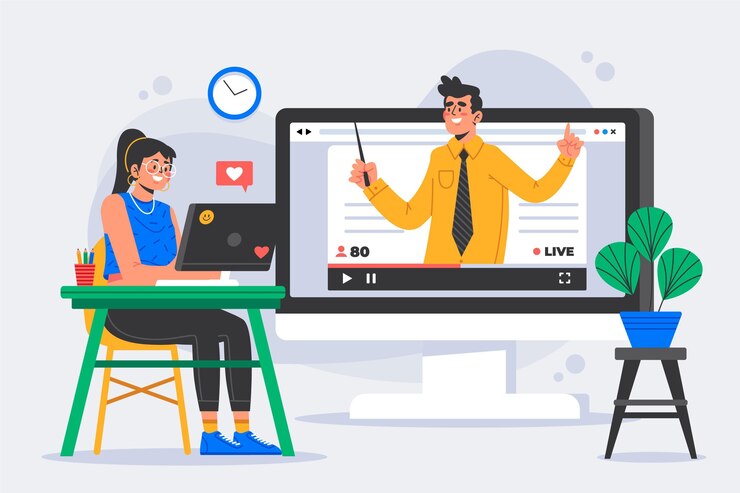
COVID-19 has altered our way of life. As residents of 2021, we are hopeful that the epidemic will be over soon, thanks to the widespread use of Coronavirus vaccines.
However, the epidemic has left its imprint on a distinct post-pandemic culture, in which working remotely has become a ‘normal’ way of life. The ways of the world have changed, and online teaching is one of the most fundamental revolutions in the education industry according to the best educational blogs.
According to the Washington Post, the transition to online education has grown significantly over the last five years, owing to factors such as greater access and general flexibility.
Last year, these figures then quadrupled, if not tripled, due to the epidemic. Whether they were ready or not, millions of educational institutions from all over the world (first world, third world, etc.) were pushed to adopt online education.
The education business is shifting and going (and staying) online as market trends change and the world learns to adapt and prosper in the new normal.
While online teaching is an efficient method of delivering knowledge, it is not without its drawbacks. Upskilling responsibilities for facilitators include learning new skills, adopting a new strategy that works for remote engagement, planning a session that is appropriate for a virtual engagement, and maximizing the use of technology.
While some people find it simple, becoming an effective online facilitator takes practice (since there’s always room for improvement!) according to best blogs on education.
Few Strategies for E-learning classes:
1. Increased Participation Through Gamification of Learning
Gamification is the process of bringing game concepts to real-life situations (such as classroom education) to increase meaningful involvement.
To engage players, gamification tactics offer prizes for participants who complete specific tasks or win the competition.
2. Adapt to your e-learning platform’s technology.
Because of the nature of technology, teaching online necessitates excellent logistical management of your classroom, which may easily go wrong. Your primary objective should be to become familiar with the most common technical glitches/limitations you encounter and to focus on finding solutions to them.
Moodle, for example, is a widely used (and free) learning management system that allows educators to establish their website with a variety of dynamic courses. Moodle provides learning and logistical solutions for everyone, whether you’re a teacher, administrator, or student.
3. Play Around With Graphic Elements
While it’s a good idea to create a strong session plan and then repeat the process, it’s also crucial to experiment with your material so that it improves over time. Don’t get overly reliant on one type of asset.
It’s crucial to realize that large blocks of text on a screen aren’t conducive to virtual classroom success. When studying remotely, attention spans are known to shorten. As a result, include visual elements whenever possible.
4. Make room for personalized feedback.
You already know how crucial feedback is for effective learning as a facilitator. It aids individuals in comprehending their development and providing clear direction on how to proceed with their studies.
The requirement for feedback is increased in virtual classes. It’s easy to become buried in front of a screen and believe that no one is watching. Try to build contact beyond the session to ensure that your learners feel connected to the session and take valuable learning home with them even after it is ended.
5. Provide Specific Directions
Because of the nature of online classrooms, you’ll want to make sure the communication protocols are in place ahead of time. Small decisions like ‘raise a hand before speaking’ (on Zoom) or ‘keep yourself muted,’ etc. are judgments you as an instructor must make and establish.
Small details matter: how you optimize your email communication, how frequently you reach out to learners, and so on.
Remember that the learners, like you, are working out the virtual learning environment. Lack of clarity on virtual etiquette in the classroom might cause students to avoid being observed for fear of doing the wrong thing according to an online educational blog.
6. Prepare for your classes ahead of time.
There’s no arguing that physically controlling a classroom is simpler than commanding one online. When a planned session fails in a real classroom, there is plenty of space for an improvised alternative to be implemented. Things may rapidly become a disaster in virtual classrooms.
Your students are not physically there, and they will almost certainly never be online at the same moment. As a result, in an online classroom, planning is critical. It helps you look more confident, as if you know what you’re doing, and so gets greater trust from your students.
7. Work on developing virtual awareness
In a virtual classroom, awareness is a critical criterion for a ‘good’ online instructor. While it’s simpler to observe student behavior in a physical classroom (someone is dozing off, someone is staring out the window at a lovely bird), it’s more difficult in an online classroom.
Educational Know How helps to understand different spectrums of knowledge and pieces of information via a wide range of best educational blogs and E-learning blog.
It’s not uncommon for learners to become distracted in the middle of a session. Rather than making it sound like a horrible thing and telling that kid to come back to class, strive to truly engage each student.
